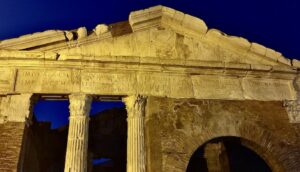
Beautify Rome!
That was one of the top priorities of Caesar Augustus soon after he came to power in 27 B.C. as the first emperor of the far-flung Empire. He was not corrupted by power. On the contrary, he was driven by a desire to improve the quality of life for his subjects and was able to show what can be achieved through magnanimity. From early on, he instituted many positive changes in the government. He greatly improved conditions for the plebeians. His principal cabinet members were two very able men, Marcus Agrippa and Gaius Maecenas, who gave him very wise counsel and valuable assistance.
Whenever these highly intelligent aides observed that the populace was getting restless and beginning to lodge grievances, they advised Augustus to distribute money and corn to the poor and provide grand festivals and spectacles to keep them amused and distracted. Augustus would follow their advice and in doing so made himself immensely popular.
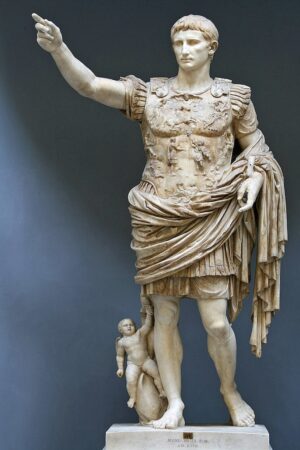
Augustus of Prima Porta, discovered at the Villa of Livia. Till Niermann, Creative Commons Attribution-Share Alike 3.0 Unported, Wikimedia Commons
He loved the city of his birth and boyhood and wanted to make his imperial capital the showpiece of the world. He longed to be able to boast – as he often later did – that he found Rome a city of brick and left her a city of marble. Or as he would put it in his native tongue, ”Memoriam relinquo quam latericiam”.
He encouraged literature and art and was himself an author. His reign saw the Golden Age of Latin Literature, spearheaded by the poets Virgil, Varius, Horace, and Ovid. Then, too, there was the great historian Livy who wrote the history of Rome up to that point.
Augustus planned to adorn Rome with architecturally splendid new temples, theaters, libraries, baths, porticoes, monuments, arches, and other lavish public works. So that he would not drain the state treasury, he strongly encouraged many of his well-heeled friends and associates to do their civic duty by funding some of these ambitious projects. The biographer Suetonius tells us this:
“He often urged men of rank and wealth to gift the city with new monuments or to restore and embellish old ones, each according to his means. And many such works were built at that time by many prominent citizens; for example, the Temple of Hercules by Marcus Philippus, the Temple of Diana by Lucius Cornificius, the Hall of Liberty by Asinius Pollo,the Temple of Saturn by Munatius Plancus, a theater by Cornelius Balbus, and by Marcus Agrippa, in particular, many magnificent structures”.
Family Honors
Another top priority of Augustus was to honor members of his family by naming various edifices after them – a temple for his great uncle, a portico for the sister he adored, another for his wife, a library and a theater for his beloved, recently deceased nephew, a library and an arcade for two grandsons who passed away as young men of great promise, and so forth.
In truth, the beautification of Rome and the monumentalizing of family members was on Augustus’ agenda even before he assumed the title of emperor. In 31 B.C., he became the lone survivor of the Second Triumvirate with his naval victory over Mark Antony in the Battle of Actium. (Marcus Lepidus, the other triumvir, had been forced out years earlier.) Now as sole ruler, Augustus at once set about building a temple in honor of his maternal great uncle, Julius Caesar (the brother of the emperor’s mother’s mother), who had been deified by the Roman Senate soon after his death.
In 29 B.C., Augustus presided over the dedication ceremonies for the relatively small yet still impressive shrine that rose over the site where the body of Caesar was cremated fifteen years earlier. The spot had previously been marked only with a tall, slender marble column bearing the honorary title: Pater Patriae (Father of His Country).
The temple had a pronaos with just four Ionic-style columns and was situated in the virtual center of the Forum, just in front of the Regia or palace of the Pontifex Maximus and to the left of the round Temple of Vesta. Officially called the Aedes Divi Julii (Aedes being a Latin synonym for Templum), the sacred edifice was enriched with artistic treasures including a painting by the Greek master Apelles of the goddess Venus, from whom Julius had always claimed descendancy.
Despite its modest size, the aedes was built on a lofty podium, or platform, which extended out and was often put to use as a stage for speakers to deliver panegyrics to Caesar on special days of the year, particularly the 15th (Ides) of March. In 11 B.C., Augustus gave a eulogy for his beloved big sister Octavia (she was two years older) whose death left him deeply bereaved. In A.D. 14, Tiberius did the same for the funeral of Augustus. A coin minted in the early part of the next century showed Hadrian delivering an oration from here.
___________________________________
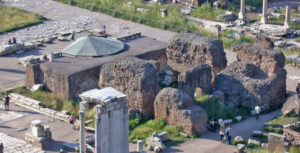
Remains of the Temple of Divine Julius, or the Temple of Caesar. Public Domain, Wikimedia Commons
___________________________________
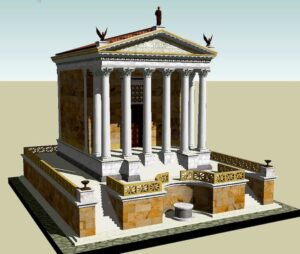
Computer generated image of the Temple of Caesar by the model maker, Lasha Tskhondia – L.VII.C. Creative Commons Attribution-Share Alike 3.0 Unported, Wikimedia Commons
___________________________________
The Temple of the Divine Julius was the first such tribute paid to a mortal in Rome. It survived intact into the late Middle Ages but was eventually quarried away for its marble. Today there remains only parts of the brick substructure. As the poet Horace liked to say: “Sic transit gloria Mundi.”
Advertisement
______________________________
______________________________
The Portico of Octavia
Down in Rome’s Jewish quarter, in the shadow of the square-domed, Babylonian styled synagogue, rises an impressive remnant of the Porticus Octaviae, among the most ambitious constructions of the Augustan Age and one of the finest public works of early Western Civilization. It stands as testimony to Augustus’ resolve to beautify his capital, foster civic pride, while honoring his kin at the same time.
What we behold today is part of the south propylaeum, or access gate, that has the aspect of a typical pagan temple, with its triangular pediment resting on an entablature supported by columns. As did its vanished twin on the north side of the portico, the propylaeum once led into a colonnaded rectangular enclave measuring one hundred and twenty by one hundred and thirty meters. Two parallel rows of roofed-over Corinthian columns – three hundred in all – formed a spectacular yet dignified open-air vestibule for two shrines, side by side, to Jupiter Stator and Juno Regina, the principal divinities of pagan Rome.
As part of his grand urban renewal program, in 23 B.C. Augustus had redesigned and enlarged an existing portico, erected on this site in 146 B.C. by Quintus Metellus, and renamed it for his dear sister who was still mourning the loss of her son Marcellus who died earlier that year.
With the Portico of Octavia, as with all his architectural projects, Augustus had deftly managed a felicitous marriage of Greek refinement to Roman splendor. While foremost a covered passage for worshippers attending temple rites, it soon began to serve also as a veritable cultural complex. Two large matching apses added to the section of the colonnade to the rear of the temples housed well-stocked public libraries– one for Latin volumes, the other for Greek. Augustus named these facilities for his late nephew Marcellus, greatly pleasing the young man’s grieving mother, who was one of the most admired Roman women for her many virtues: her noble character, dignity, kindness, generosity, devotion to family, and compassion for the poor.
The portico itself was also a museum of sorts, thanks to its vast collection of statuary, including thirty-four equestrian bronzes produced by the renowned sculptor Lysippus. Carted back to Rome from a monumental park in Macedonia, these masterpieces represented Alexander the Great with his cavalry at the Battle of Granico. Also gracing the structure was an outstanding carving of Cornelia, proud but saddened mother of the slain civil rights advocates, Tiberius and Gaius Gracchus. This we learn from Pliny the Elder in his magnum opus, Naturalis Historiae.
The same writer and researcher offers a charming anecdote on the two Greek architects hired by Augustus to design the entire complex. Their names were Saurus and Batrachus, which meant in their language respectively, lizard and frog. When their request for permission to engrave their names on the project was denied, they found another way to leave their imprint for posterity. On the bases of some of the temple columns they carved, in relief, a lizard and a frog.
________________________________
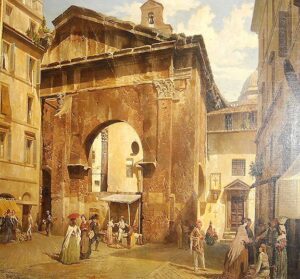
Portico of Octavia in Rome by Luigi Bazzani. Public Domain, Wikimedia Commons
________________________________
Pliny also relates another somewhat curious development. When the temples were completed and ready to receive their statues, the deliverymen by mistake set up the colossus and other symbols of Jupiter in the cella of Juno’s sanctuary and vice-versa. When the priests of both cults discovered the error, they were shocked and distraught. They submitted the problem to the College of Augurs who, after much deliberation, decided it was the will of the gods. Thus things were left as they were.
After its dedication, the Portico of Octavia soon became one of the city’s favorite gathering places and pleasure grounds. People came in streams each day to enjoy the architectural ambience, the objets d’art, and the relief from the relentless turmoil and din of the surrounding streets. It was always an eclectic collection of visitors: groups of out-of-towners being shown about by free-lance guides, clusters of friends just hanging out, teachers with their little charges in tow, businessmen negotiating peripatetically, lovers promenading hand-in-hand amid a romantic forest of tall sturdy marble pillars, all of them shielded from a torrid sun or a soaking rain, all of them well-behaved and soft-spoken out of respect for the sacred character of the place.
With the decline and fall of Rome, the portico and its temples, like most other public sites, suffered desecration and dismantlement stone by stone. Before long, homely dwellings encroached upon the gloomy ruins. Sometime in the Middle Ages, the one surviving gateway was partially shored up with a red-brick arch, relieving two tottering columns from duty.
_______________________________
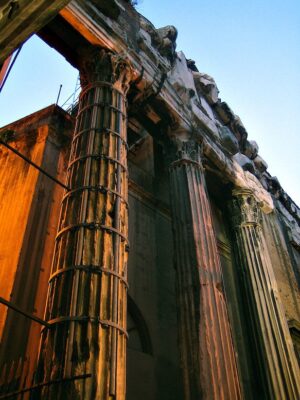
The church of S. Angelo in Pescheria, the Holy Angel in the Fish Market, is built up against the back of the columns, which were restored rather badly after a fire in AD 283 using bits of other columns. Anthony Majanlahti, Creative Commons Attribution 2.0 Generic, Wikimedia Commons
_______________________________
Early in the sixth century, Pope Boniface II built a church to St. Michael the Archangel right behind the old gateway, thus rendering it a unique pagan ceremonial entrance to a Chrisitian house of worship.
At yet some later time, this church came to be known as Sant’ Angelo in Pescheria because of the fish market that thrived here just outside the temple precincts, from pre-imperial times to the mid nineteenth century. Still embedded in the outer wall of the brick arch is an age-old marble slab that reveals how the Weights and Measures commissioners from city hall cut themselves in on a piece of the market’s action:
CAPITA PISCIUM HOC MARMORIO SCHEMATE LONGITUDINE MAIORUM USQUE AD PRIMAS PINNAS INCLUSIVE CONSERVATORIBUS DANTO.
“Let there be given to the wardens the heads, down to the fore-fins, of all fish that are longer than this marble measure.”
A rather cozy deal for the officials, inasmuch as the Romans of the time considered this portion of the fish the most desirable, and especially good for making their ever popular fish soups. It is interesting to note that even in our current era the numerous hosterie of the district all boast of their excellent zuppa di pesce, especially the colorful eatery called Da Gigetto al Portico d’Ottavia.
Porticoes were known as far back as the second century B.C. They were often located adjacent to outdoor theaters, providing shelter for the spectators in the event of a sudden storm. Pompey had one next to his theater.
They were also popular rendezvous spots, particularly in the evening for the traditional stroll. No one wanted to pass up this daily opportunity to see and be seen. (Just like today’s Romans.) What the piazza is to the current populace, the porticus was to the ancients. The idea was copied often. At the peak of the imperial era there were as many as twenty five porticoes in Rome.
________________________________
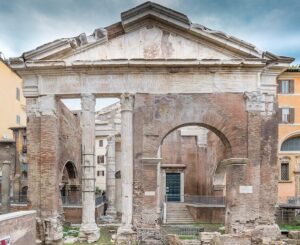
The Portico of Octavia. Rabax63, Creative Commons Attribution-Share Alike 4.0 International, Wikimedia Commons
________________________________
The Portico of Livia
By 15 B.C. Augustus was again feeling the itch to name a public project for a relative, this time for his wife Livia. The Carinae quarter of old Rome, on the Esquiline Hill, was a fashionable neighborhood with beautiful estates. One wealthy citizen, Vedius Pollio, had a magnificent mansion there on a sprawling piece of property, all of which he left in his will to his long-time friend, the Emperor Augustus. At the death of the benefactor in 15 B.C, Augustus razed the lavish dwelling to clear the way for the Porticus Liviae.
Construction took nearly eight years on this awesome enclave. Augustus proudly presided and orated at dedication ceremonies in January of 7 B.C. While not a trace of it remains today, we know a few things about this pleasure ground thanks to mention of it in the writings of Livy, Suetonius, Ovid and Pliny the Elder and his nephew Pliny the Younger.
Ovid, whose risque literary efforts would ultimately draw the disapproval of the somewhat puritanical emperor who drove the poet into exile, cites the monument in his Ars Armatoria:
“Do not fail to visit that lovely portico which, ornamented with ancient paintings, is called the Portico of Livia”.
In another of his works, Fasti, Ovid waxes poetic once again:
“Where Livia’s Colonnade now stands there once stood a huge palace, occupying an area larger than many towns. Caesar Augustus decided to level the vast structure and destroy so much wealth to which he himself was heir, to provide the space for a community gathering place that would pay honor to his wife.”
Like most porticoes, that of Livia was rectangular, some 120 meters long and nearly 100 wide. Among other things, such as art works, it also featured lovely gardens and areas for strolling. In the midst of the gardens was a beautiful ara, or altar honoring the goddess Concordia, who, as her name indicates, was the goddess of Harmony and to whom Livia had a special devotion. Pliny the Elder writes of a beautiful colorful vine that draped over the walkways (perhaps Wisteria).
_________________________________
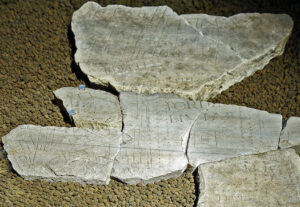
Fragments of the Forma Urbis showing the Portico of Livia. Ptyx, Creative Commons Attribution-Share Alike 4.0 International, Wikimedia Commons
_________________________________
The Theater of Marcellus
The year 11 B.C. saw Augustus’ next public-family project, the Theatrum Marcelli, a state of the art theater honoring the late son of Octavia. Marcellus, born in 42 B.C., was a bright, precocious, and handsome lad who already held public office, aedile, i.e. commissioner of public works and festivals, while still in his teens. He was the apple of his uncle’s eye. In fact Augustus, whose only offspring was his daughter Julia, adopted Marcellus as his son and was grooming him as his successor to ensure that someone of his own bloodline would ascend to the throne. Tragically, Marcellus died at the age of nineteen from a prolonged fever. The emperor was grief stricken, Octavia inconsolable. They both had high hopes for the gifted young man.
Marcellus was commemorated by Virgil in the Aeneid (Book 6, verses 860-886). One evening some years later, at a palace dinner party, the poet sang the pertinent lines. Octavia fainted, overcome with emotion. Augustus wept.
The Theater of Marcellus was completed just in time for Octavia to witness the solemn dedication. A few months later she too was gone.
During the Republic, the prudish censors had blocked construction of permanent theaters since they considered most plays to be a threat to public morality. Only wooden theaters that could be easily dismantled after a program of performances ran its course were allowed. At the end of the Republic, Pompey built the first stone theater. Ten years later, the Theater of Balbus went up a few blocks away. Julius Caesar began construction of a permanent theater which was left unfinished with his murder in 44 B.C. About three decades later Augustus decided to complete work on it in a grandiose manner. He bought up numerous private property lots in the vicinity so that the theater could be greatly enlarged. The site was just a stone’s throw from the Portico of Octavia. When the project was finished, the emperor formally dedicated it to the memory of Marcellus. (The location had been chosen by Julius Caesar because of the nearness of the already ancient Temple of Apollo (431 B.C.), the god of music, poetry and art.)
Theatrum Marcelli could seat comfortably 20,000 spectators. On the ground floor was the throne of the emperor surrounded by a semi-circle of seats for the proud senators, while above them, up to the crowning colonnade, in ever lengthening tiers of seats sat first the white toga-clad patricians, then the knights (Rome’s sort of middle-class). The uppermost seating section was for the plebeians.
The exterior wall consisted of three stories of open arcades, each flanked with impressive pilasters: those on the ground level had Doric capitals, the second Ionic, the top level Corinthian. Enough of the theater survives to our time that we can observe and appreciate the Greek touch. This structure served as the inspiration for the architect Gaudentius, who designed the Colosseum almost a century later.
Unlike the Athenians, however, who constructed their public buildings entirely of marble, the pragmatic Romans used a brick substructure and veneered it with marble, or to be more precise, with travertine, a limestone from the abundant quarries out near Tibur ( the modern Tivoli), twenty miles southeast of Rome.
Augustus, a man of consummate propriety and dignity, rarely allowed the old bawdy comedies. He preferred refined theatrical performances, pantomimes, poetry recitals, dance, and concerts. But despite his best efforts to elevate his countrymen’s comportment, many Romans were not particularly well-behaved at theater. They did not go to witness drama, tragedy and art but rather just as a pastime and for amusement, and humbug as was proven by the unrest, murmur, or downright impolite noise among the audience. Horace compared it to the rustling of wind among the trees of the forest, or the roar of the ocean’s waves.
When a favorite politician went to take his seat there would be spontaneous applause and cheers. (Such expression of popular favor, Cicero informs us, was purchased and paid for by ambitious office holders and seekers.} A not so favorite political figure would be greeted with boos and hisses and catcalls laced with obscenities. Sometimes brawls would break out in the audience. When the theater-goers were not happy with a presentation they would not hesitate to let the actors know. {The acting profession was not highly regarded or respected. It was considered to be one step above prostitution.}
The Theatrum Marcelli remained intact until A.D. 365 when despoliation started. Some of the travertine blocks on the ground level were removed for use in the restoration of the Pons Cestius, one of the two bridges that still link the Tiber Island to the city. With the fall of Rome came the fall of many of its architectural treasures. The third tier of Marcellus’ theater has disappeared in the course of nineteen centuries of metamorphoses in which the structure was put to use as a quarry, a fortress, a palace.
From the 12th to the 14th centuries the powerful Pierleoni family used it as a stronghold. The constant warfare in which they were engaged with their equally powerful neighbors caused great destruction. The interior was reduced to a mass of ruins forming a mound upon which the architect Peruzzi built the Palazzo Savelli, another powerhouse Roman clan that somehow came into possession of the property in the 15th century. Over the ruined cavea (seating sections) Peruzzi laid out plush gardens for the Savellis. Today the rooms of the old Palazzo have been partitioned into small apartments where the third tier used to be. They are inhabited by low-income families whose laundry can be seen drying at the windows. Nevertheless, even in ruins, the Theater of Marcellus remains an imposing sight and site.
__________________________________
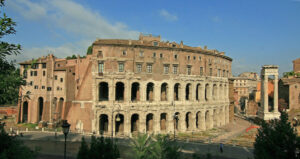
Above and below: The Theater of Marcellus as it appears today. Jensens, Public Domain, Wikimedia Commons
__________________________________
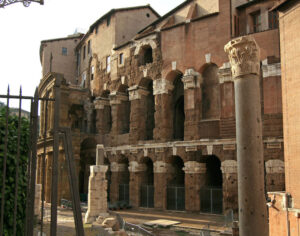
__________________________________
********
Around the year 2 B.C., Augustus had his architect design a two-tiered arcade adjacent to the Basilica Aemilia in the Forum. In this elegant structure there were numerous tabernae, i.e. small shops, vending an assortment of goods. This work he named for his grandsons, Gaius and Lucius, who had recently come of age and were given the title of Consul. (By this time the emperor had reduced the consulship to an honorary office.) Each young man was also named Princeps Juventutis (Prince of the Youth).
Augustus was so impressed with the intelligence, character, and political savvy of each grandson that he adopted them with the aim that as his sons they would inherit a co-emperorship upon his passing. Sadly, though, they, like Marcellus, would die at a young age, in their early twenties, Gaius in A.D. 2 and Lucius two years later.
There is some confusion on exactly what was named for them – just the arcade, or that plus the basilica as well. Suetonius makes mention of porticum basilicamque Gai et Luci. At any rate all that is left of the arcade is this Latin inscription on massive travertine blocks:
I CAESAR AUGUSTI F DIVI N PRINCIPI IUVENTUTIS COS DESIG CUM ESSET ANN NAT XIIII AUG
SENATUS
To Lucius Caesar, son of Augustus, grandson of the Divine, Prince of the Youth, Consul-Designate when he was fourteen years old.
The Senate
Just two or three years after their untimely deaths, Augustus, still grieving, ordered the building of a modest sized Roman-style temple in far-off Gaul, in a town called, at the time, Nemausus (the modern Nimes in southern France).
This stately edifice he also dedicated to Gaius and Lucius. The attractive temple survives, virtually totally intact, to our time. It rests on a podium about ten feet high and boasts a graceful pediment and entablature and a facade of six Corinthian columns. While the dedicatory inscription is gone, a French scholar in 1758, by studying the pockmarks in the frieze and architrave that held the bronze lettering in place, was able to deduce the following:
To Gaius, son of Augustus, Consul To Lucius, son of Augustus, Consul designate, Princes of Youth.
(Note: The French of today for some strange reason call this memorial temple, Maison Carree which means “Square House” – strange, because it is neither square nor a house.)
__________________________________
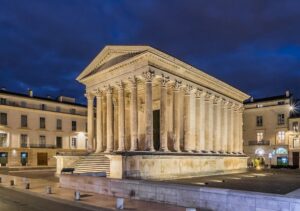
Maison Carrée in Nîmes, Gard, France. Krzysztof Golik, Creative Commons Attribution-Share Alike 4.0 International, Wikimedia Commons
__________________________________
Curiously, or perhaps not so curiously, Augustus never named anything for his only offspring, daughter Julia, who was the talk of the town. He was disgusted, nay appalled, by her reckless way of life and her promiscuity. This exception aside, however, it was still clear that with the long-reigning emperor (27 B.C – A.D. 14), family came first.
Cover Image, Top Left: Portico of Octavia Detail. MumblerJamie, Creative Commons Attribution-Share Alike 2.0 Generic, Wikimedia Commons
Advertisement
_______________________________

Don’t miss out on this unforgettable evening as Dr. Hawass reveals the most closely guarded secrets of ancient Egypt and presents his groundbreaking new discoveries and latest research live on stage. As the man behind all major discoveries in Egypt over the last few decades and director of several ongoing archaeological projects, Dr. Hawass may yet surprise you with unexpected revelations that will make news across the world.
_______________________________






